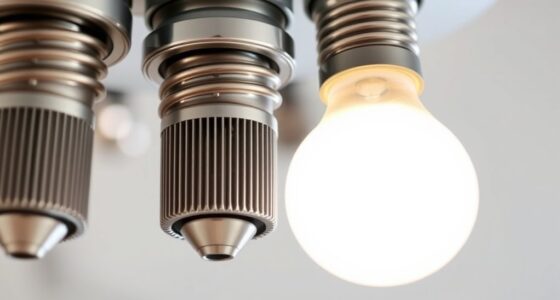Many everyday devices sneak power when turned off or idle, adding up over time. Your smartphone chargers, laptops, TVs, gaming consoles, cable boxes, air purifiers, small kitchen appliances, electric toothbrush chargers, and decorative lights can all draw phantom loads. Unplugging or using power strips can help cut these hidden energy costs. If you want to discover simple ways to save money and reduce waste, keep exploring these tips and tricks.
Key Takeaways
- Many household devices like microwaves, coffee makers, and routers draw power in standby mode, causing phantom loads.
- Unplugging devices or using power strips can effectively eliminate unnecessary standby power consumption.
- Devices with digital displays or auto-start features tend to have higher standby energy use.
- Managing and turning off smart home gadgets and electronics reduces overall phantom load.
- Regularly reviewing device settings and switching to energy-efficient models helps minimize sneak power usage.
Smartphone Chargers
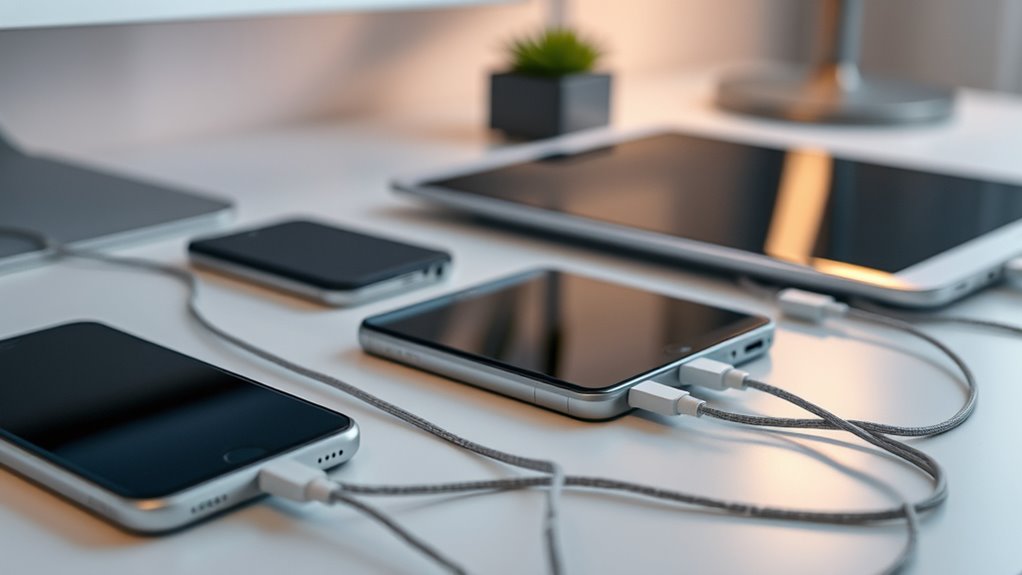
Have you ever noticed that your phone charger still draws power even when your phone isn’t connected? That’s because many chargers continue to consume energy, contributing to phantom loads. Over time, this can impact your device’s battery efficiency, especially if your phone experiences frequent charging cycles. Constantly leaving chargers plugged in can subtly wear down your battery’s health, reducing its overall lifespan. To preserve battery efficiency, unplug your charger once your phone reaches 100% or when it’s not in use. This simple habit helps prevent unnecessary energy drain and minimizes wear on your device’s battery. Being mindful of charging cycles and energy consumption can be minimized by using smart chargers or power strips with switches. Additionally, using chargers that are vetted and certified can ensure safer and more efficient energy use. Proper charger maintenance also ensures optimal performance and safety over time. Regularly inspecting your charging cables and adapters for damage can further prevent potential safety hazards and maintain charger efficiency.
Laptop Power Adapters
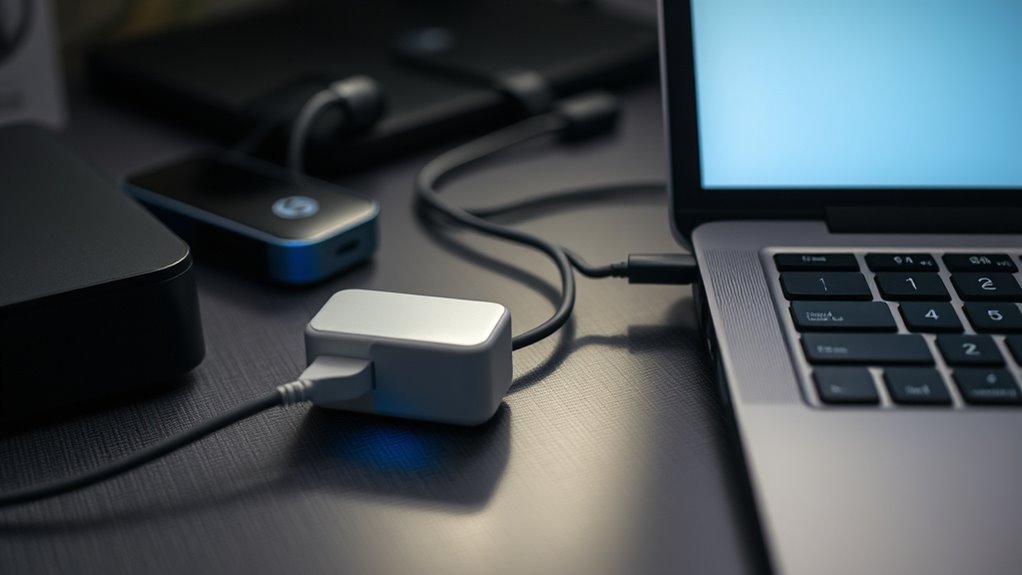
Even when your laptop isn’t charging, its power adapter can continue to draw energy from the outlet, contributing to phantom loads. Many chargers have poor energy efficiency, especially older or generic models. The charger design plays a significant role in how much power is wasted when not in use. Modern adapters are often built with features that reduce standby power consumption, making them more energy-efficient. To cut down on phantom loads, unplug your laptop charger when you’re not using it, or invest in a model with better energy efficiency ratings. Some chargers include power switches or smarter circuitry that limit unnecessary energy drain. Improving charger design and being mindful of standby power can help reduce your overall energy consumption and lower your electricity bills. Incorporating energy-efficient components, such as power management circuitry, can further minimize standby energy use. Additionally, choosing chargers with regulatory certifications can ensure better compliance with energy efficiency standards. Being aware of phantom load impacts can motivate more mindful energy use in daily routines, especially when selecting devices with energy-saving features. Recognizing the role of energy efficiency in device design encourages consumers to prioritize environmentally friendly options.
Television Sets
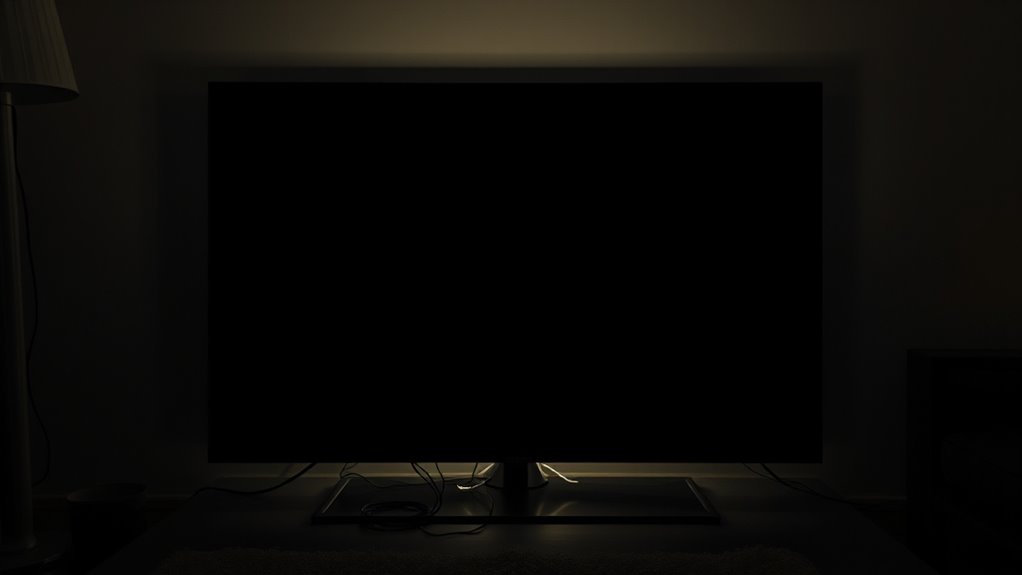
Just like laptop chargers, television sets can also draw power even when they’re turned off, contributing to phantom loads. This sneaky energy drain impacts your energy efficiency and adds to your electricity bill. To reduce this, focus on effective power management strategies. Additionally, selecting TVs with better energy efficiency ratings can significantly decrease standby power consumption. Incorporating energy-saving features into your TV’s settings can further optimize power use and reduce unnecessary energy waste. Understanding these points helps you minimize unnecessary energy consumption. By managing your TV’s power effectively, you not only save money but also lessen your environmental footprint. Small steps like these can lead to a significant reduction in phantom loads over time. Recognizing the role of energy-efficient appliances can further enhance your efforts to conserve power. Being aware of standby power consumption helps you make more informed choices about your home electronics.
Gaming Consoles

Gaming consoles can continue to draw power even when you’re not actively playing, contributing to phantom loads. This often happens in console standby modes, where the system remains partially powered for quick startup and updates. While convenient, leaving your console in standby mode consumes energy over time. Additionally, gaming accessories like controllers, external hard drives, and charging docks can add to this phantom power drain. To reduce unnecessary energy use, consider turning off your console completely when not in use or unplugging it. Managing console standby modes can help cut down on hidden electricity costs. Being mindful of these small power draws ensures you’re not wasting energy and helps keep your household more energy-efficient. Proper power management can further minimize these hidden energy losses, and energy-efficient practices can save you money on your energy bills. Regularly reviewing your device settings can also optimize energy savings and reduce phantom energy consumption.
Cable and Satellite Boxes

Cable and satellite boxes often stay on standby to provide quick access to channels and recordings, but this convenience comes with hidden energy costs. Leaving them on increases your phantom load, wasting power even when you’re not using them. To reduce this, you can practice effective power management by turning devices off when not in use or using energy monitoring tools to track consumption. This approach helps cut unnecessary energy use and saves money on your utility bills. Energy consumption can vary depending on the device and its settings, so being aware of these factors can further improve your efforts to conserve energy. Understanding industry trends related to device efficiency can also help you choose more energy-friendly models. Additionally, selecting devices with energy-saving features can further reduce phantom loads and enhance overall home efficiency. Being mindful of device standby power can lead to significant savings over time.
Microwave Ovens

Many microwave ovens draw power even when they’re not in use, contributing to standby energy waste. This unnecessary energy use adds up over time, increasing your electricity bill and environmental impact. Using the power button to turn off your microwave completely can help reduce this phantom load. Additionally, being aware of energy-efficient appliances can further minimize unnecessary power consumption in your home. Implementing smart power strips can also prevent devices from drawing power when they are not actively in use. Understanding standby power consumption can help you identify other devices around your home that may be contributing to unnecessary energy drain. Recognizing electrical load management is essential for optimizing overall energy efficiency and reducing costs.
Standby Power Consumption
Even when your microwave isn’t in use, it still draws power to stay ready for quick operation. This standby power consumption can add up over time, impacting your overall energy efficiency. To improve power management, consider unplugging your microwave when not in use or choosing models with low standby power ratings.
Understanding these factors helps you reduce unnecessary energy waste. Keep in mind:
- Many microwaves consume power even when turned off
- Energy-efficient models reduce standby power
- Unplugging devices prevents phantom loads
- Proper power management extends appliance lifespan
Energy Waste Concerns
Are microwave ovens contributing more to energy waste than you realize? Even when not in use, they often draw phantom loads, adding to your energy bills. This waste can be reduced by choosing energy-efficient appliances and supporting renewable energy sources. To visualize this, consider the table below:
| Action | Impact |
|---|---|
| Unplug when idle | Eliminates standby power draw |
| Use energy-efficient microwave models | Reduces overall energy consumption |
| Opt for renewable energy sources | Lowers carbon footprint |
| Keep microwave clean and maintained | Ensures best efficiency |
| Limit use to necessary heating | Saves energy and reduces waste |
Power Button Usage
Have you ever wondered how often you leave your microwave on standby mode? Using the power button to fully shut down your microwave can markedly reduce phantom loads. Instead of relying on standby, always turn off the device when not in use. Proper device shutdown prevents unnecessary power drain and extends the appliance’s lifespan.
Keep in mind:
- Many microwaves still draw power when on standby
- Regularly pressing the power button helps conserve energy
- Fully shutting down reduces phantom loads
- It’s a quick, simple step to lower your electricity bill
Coffee Makers
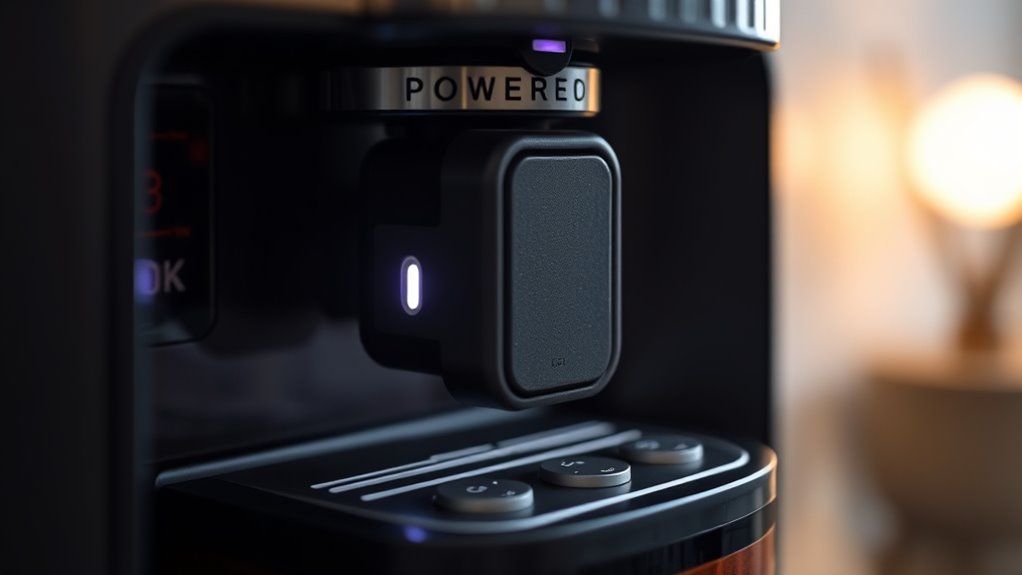
Did you know your coffee maker might be draining power even when it’s turned off? Many models draw standby energy, contributing to phantom loads. To save energy, consider unplugging your coffee maker after use or using a power strip with a switch. During coffee brewing, energy consumption is normal, but once you’re done, cutting power helps reduce waste. Implementing simple energy-saving tips, like unplugging when not in use, can lower your electricity bill and lessen environmental impact. If your coffee maker has a digital clock or auto-start feature, it may consume additional power even when idle. Be mindful of these features and turn off or unplug your device to prevent unnecessary phantom loads, especially if you’re aiming for a more energy-efficient home.
Smart Home Devices

Ever wonder if your smart home devices are quietly draining power when you’re not using them? These devices often stay in device standby mode, consuming energy efficiency even when idle. While they offer convenience, they can contribute to phantom loads over time. To reduce this, consider:
- Unplugging devices when not in use
- Using smart power strips
- Adjusting settings to minimize standby power
- Opting for devices with low standby consumption
Understanding which devices sneak power in the background helps you make smarter choices. Even small amounts of power drain add up, impacting your energy bills. Managing device standby is a simple step toward a more energy-efficient home, preventing unnecessary phantom loads and saving you money.
Clocks and Alarm Systems

Many household devices draw power even when they’re turned off, including clocks and alarm systems that run continuously to keep accurate time and guarantee alarms trigger on schedule. To reduce phantom loads from these devices, consider implementing energy saving strategies like unplugging clocks when not in use or using power strips with switches. Some alarm systems have low-power standby modes that consume minimal energy, so check your device settings and activate these features if available. Regularly reviewing your power management tips can help identify devices that unnecessarily draw power, saving you money and reducing your overall energy footprint. While clocks and alarm systems may seem minor, their constant power draw adds up over time. Small changes can make a significant difference in your home’s energy efficiency.
Wireless Routers

Have you considered how much energy your wireless router consumes even when you’re not actively using the internet? Wireless router energy can add up over time, especially if it stays in router standby mode for long periods. Many routers continue to draw power in the background, even when idle, contributing to phantom loads. To reduce this, consider turning off your router when not in use or enabling power-saving features. Understanding these points helps manage energy consumption better:
- Routers often stay in standby mode, consuming power constantly
- Power-saving settings can cut unnecessary energy use
- Unplugging during long absences prevents phantom loads
- Monitoring energy use highlights hidden power drains
Being mindful of your wireless router’s energy use can lower your bills and reduce environmental impact.
External Hard Drives

Just as leaving your wireless router on consumes energy even when idle, external hard drives can also draw power even when you’re not actively using them. These phantom loads add up over time, increasing your electricity bill unnecessarily. To reduce this waste, consider unplugging your external drives when not in use or enabling power-saving settings. Regular hard drive maintenance, like safely ejecting the device and checking for errors, helps prolong its lifespan and ensures reliable data backup strategies. If you use an external drive frequently, investing in a model with an automatic sleep mode can cut down on power consumption. Being mindful of these small energy drains not only saves money but also supports a more sustainable environment.
Bluetooth Speakers and Headphones

Bluetooth speakers and headphones continue to draw power even when they’re not actively in use, contributing to unnecessary energy consumption. This lingering power drain affects the overall energy efficiency of your home. To reduce this phantom load, consider unplugging your Bluetooth devices when not in use or using smart power strips. Keep in mind:
- Many Bluetooth devices enter a low-power standby mode, still consuming some energy.
- Regularly turning off devices can prevent continuous phantom loads.
- Upgrading to newer models often improves energy efficiency and reduces standby power.
- Managing your Bluetooth devices thoughtfully can lower your overall electricity bill and environmental impact.
Being mindful of these devices helps you cut down on wasted energy and supports a more sustainable lifestyle.
Printers and Scanners
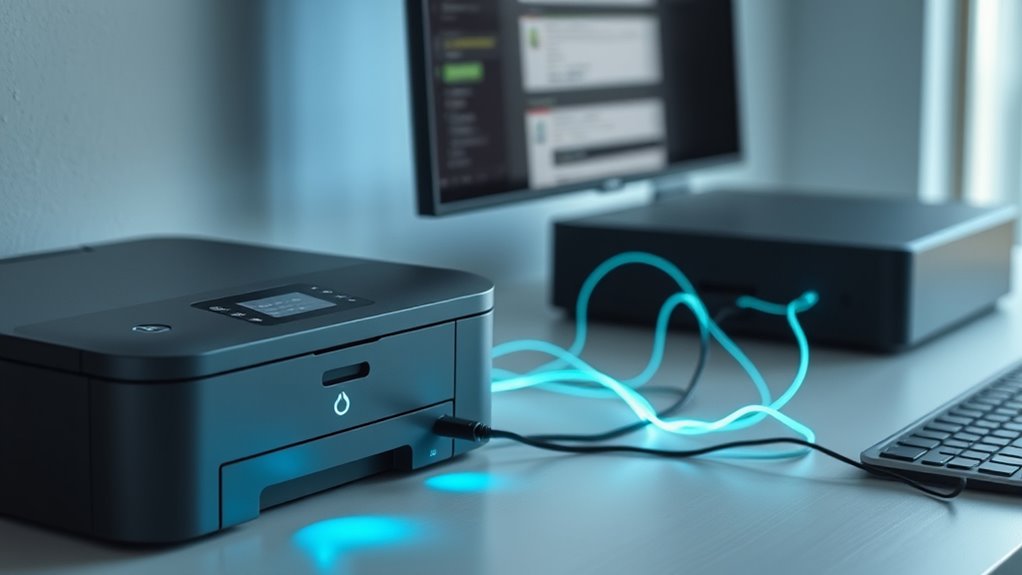
Printers and scanners often use standby power even when you’re not using them, leading to unnecessary energy waste. This standby power drain can add up on your energy bills over time. Unplugging these devices when they’re not in use can save you money and reduce your environmental impact.
Standby Power Drain
Ever wonder how much energy your printers and scanners waste when they’re turned off but still plugged in? That’s standby power drain at work, silently consuming energy and reducing your device’s energy efficiency. Many devices enter low-power modes to support quick startup, but this often leads to unnecessary energy use. To improve power management, consider unplugging devices when not in use or using smart power strips. Look for printers and scanners with energy-saving features that minimize standby consumption. Remember, even small amounts of wasted power add up over time, impacting your electricity bill and the environment. By choosing devices with better power management and being mindful of standby modes, you can cut down on phantom loads and support a more sustainable home.
Energy Waste Costs
Even when devices are in standby mode, they continue to consume energy that adds up over time. Printers and scanners often stay partially powered, silently wasting electricity without your knowledge. This invisible energy drain impacts your overall energy efficiency, leading to higher utility bills. Over months and years, these small, continuous power draws accumulate into significant costs. By reducing phantom loads, you can improve your energy efficiency and realize real cost savings. Turning off printers and scanners when not in use, or unplugging them entirely, prevents unnecessary energy waste. Taking these simple steps helps you cut expenses and reduces your environmental footprint, making your home or office more sustainable and cost-effective in the long run.
Unplugging Benefits
Unplugging printers and scanners offers immediate benefits by eliminating unnecessary energy consumption. When devices aren’t in use, they still draw phantom loads that waste power and decrease overall energy efficiency. By unplugging these devices, you reduce your electricity bill and help the environment. Here are some unplugging tips to maximize savings:
- Use power strips to easily switch off multiple devices at once
- Schedule regular unplugging sessions for idle equipment
- Store rarely used devices in a place where they’re easy to disconnect
- Set reminders to unplug devices after completing your tasks
Taking these simple steps not only conserves energy but also prolongs the lifespan of your printers and scanners. Remember, small actions like unplugging can make a significant difference in reducing your phantom load footprint.
Air Purifiers and Humidifiers

Air purifiers and humidifiers are common household devices that run continuously to improve air quality and comfort, but many of them draw power even when not actively in use. This phantom load can add up over time, wasting energy and increasing your bills. To minimize this, you should regularly perform air purifier maintenance, ensuring filters are clean and functioning properly. When replacing the humidifier filter, do so promptly to keep the device running efficiently and prevent unnecessary power draw. Some models have standby modes or timers that can help reduce energy consumption when the devices aren’t needed. Being mindful of these devices’ power habits helps you cut down on phantom loads and keeps your energy use more efficient.
Small Kitchen Appliances

Many small kitchen appliances draw power even when turned off, adding to your energy costs. This standby power drain often goes unnoticed but can be minimized by unplugging devices when not in use. Using simple unplugging tips helps you cut hidden energy costs and save money.
Standby Power Drain
Ever wonder how small kitchen appliances like coffee makers and microwave clocks silently consume power even when you’re not using them? That’s standby power drain at work, quietly wasting energy and increasing your utility bills. To improve energy conservation and manage power effectively, consider these tips:
- Unplug appliances when not in use to prevent unnecessary phantom loads.
- Use power strips to easily switch off multiple devices at once.
- Opt for appliances with energy-saving features or automatic shutoff.
- Be mindful of devices with digital clocks or indicator lights that stay on constantly.
Understanding standby power drain helps you take control of your energy use, reducing waste and supporting smarter power management at home. Cutting down on phantom loads benefits both your wallet and the environment.
Hidden Energy Costs
Small kitchen appliances like blenders, toasters, and slow cookers often run up hidden energy costs because their power consumption isn’t immediately obvious. Many of these devices draw power even when not in use, leading to unnecessary energy drain. Improving their energy efficiency can reduce these costs, but it requires awareness of their consumption patterns. Monitoring your appliance usage helps identify which items consume the most power, even when idle. For example, leaving a toaster plugged in or a slow cooker on standby can add up over time. By understanding their hidden energy costs, you can make smarter choices—unplugging appliances when not in use or choosing models with better energy efficiency ratings. Small actions can substantially lower your overall energy bills.
Unplugging Tips
Unplugging small kitchen appliances when you’re not using them is one of the simplest ways to cut down on hidden energy costs. Effective power management starts with device unplugging, preventing phantom loads from sneaking energy. To make this easier, consider these tips:
- Keep appliances on a power strip for quick disconnection
- Unplug chargers once devices are fully charged
- Schedule regular unplugging routines for seldom-used devices
- Use smart outlets that turn off automatically when not in use
Electric Toothbrush Chargers
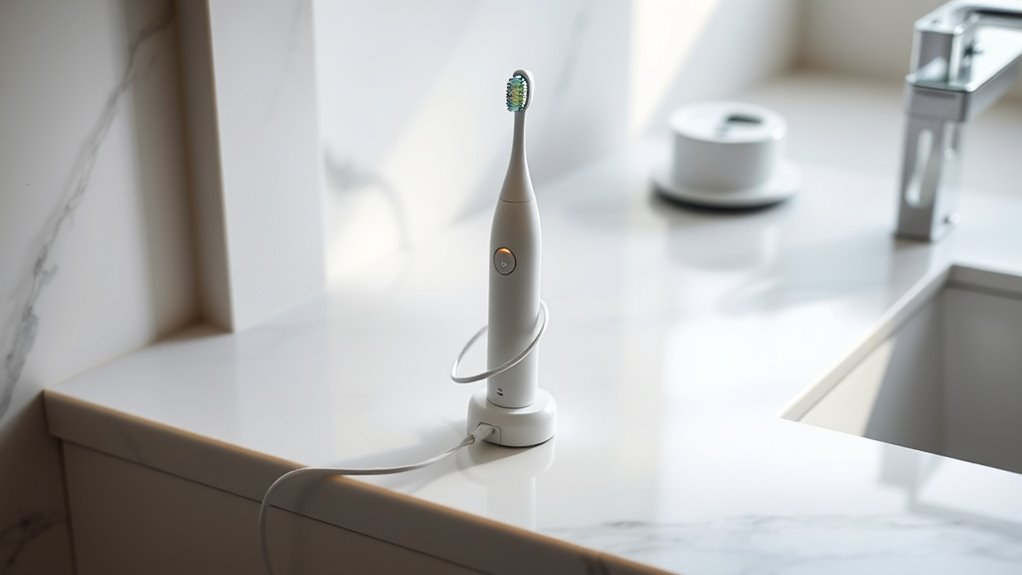
Did you know that your electric toothbrush charger could be silently draining power even when it’s not in use? Many people leave their electric toothbrush chargers plugged in, unaware that they continue to draw small amounts of energy. The design of your charging station plays a big role in this phantom load. Some chargers have minimal standby power, while others are less efficient. To reduce unnecessary energy consumption, consider unplugging your electric toothbrush charger when it’s not actively charging. Alternatively, you can look for chargers with better charging station design features, such as automatic shut-off or low standby power modes. Being mindful of how your chargers are set up helps lower your energy bills and reduces your overall carbon footprint.
Decorative and Accent Lighting
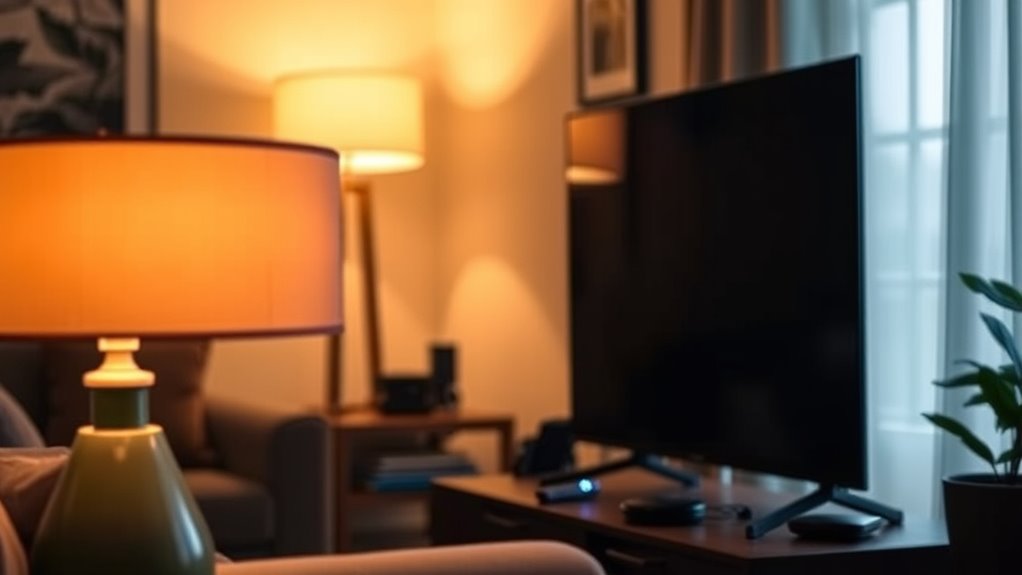
Have you ever considered how decorative and accent lighting can silently increase your energy bills? Many decorative fixtures, like ambient lighting, stay on longer than needed or draw power even when turned off. These phantom loads add up over time, wasting energy and money. To reduce this, consider unplugging decorative fixtures when not in use or installing smart switches.
Remember:
- Some ambient lighting remains in standby mode unnecessarily
- Decorative fixtures can draw power even when off
- Using timers or smart plugs helps control energy use
- Upgrading to energy-efficient LEDs minimizes phantom loads
Being mindful of these small, continuous power drains helps you cut costs and conserve energy. Small changes in handling decorative and accent lighting can make a significant difference in your overall energy savings.
Frequently Asked Questions
How Can I Identify Phantom Loads in My Home?
To spot phantom loads in your home, start with outlet testing during an energy audit or manually check each outlet. Turn off devices and see if the indicator lights stay on or if the devices still draw power. Use a power meter to measure energy use directly from outlets. This helps you identify which devices are sneaking power, so you can unplug or switch them off to save energy and reduce costs.
What Are the Environmental Impacts of Phantom Energy Consumption?
Imagine tiny, invisible ghosts draining your home’s energy—phantom loads contribute markedly to environmental harm. By wasting power, you increase your carbon footprint and rely more on non-renewable energy sources, accelerating climate change. Reducing these sneaky devices helps lessen environmental impacts, supports renewable energy use, and conserves resources. You can make a difference by unplugging devices when not in use, cutting emissions, and protecting the planet for future generations.
Are There Affordable Devices to Reduce Phantom Loads?
Yes, there are affordable energy-saving gadgets and power strip solutions to cut down on phantom loads. You can buy smart power strips that automatically turn off devices when not in use, or simple surge protectors with switches to easily unplug multiple devices at once. These options are budget-friendly and straightforward to implement, helping you save energy and reduce your environmental impact without breaking the bank.
Can Unplugging Devices Really Save Money on Energy Bills?
Yes, unplugging devices can save you money on energy bills by reducing standby power. Using energy monitoring tools helps you see how much appliance standby consumes. When you unplug devices not in use, you eliminate phantom loads, which can add up over time. Investing in smart power strips or timers makes it easier to cut off power completely, ensuring you’re not paying for energy your devices don’t need.
How Do Smart Home Systems Help Manage Phantom Energy Use?
Think of your smart home system as a vigilant guard, constantly watching over your devices. With smart home automation, you can schedule or remotely turn off gadgets, preventing phantom energy use. Energy monitoring features give you real-time insights into power consumption, helping you identify energy hogs and cut costs. This proactive approach makes managing phantom loads easier, saving you money and reducing waste without sacrificing convenience or comfort.
Conclusion
Did you know that these phantom loads can waste up to 10% of your home’s energy? That means your devices are sneaking power even when you’re not using them, costing you money and harming the environment. By unplugging chargers and turning off unused electronics, you can cut down on this hidden energy drain. Taking a few simple steps now can save you money and reduce your carbon footprint in the long run.


